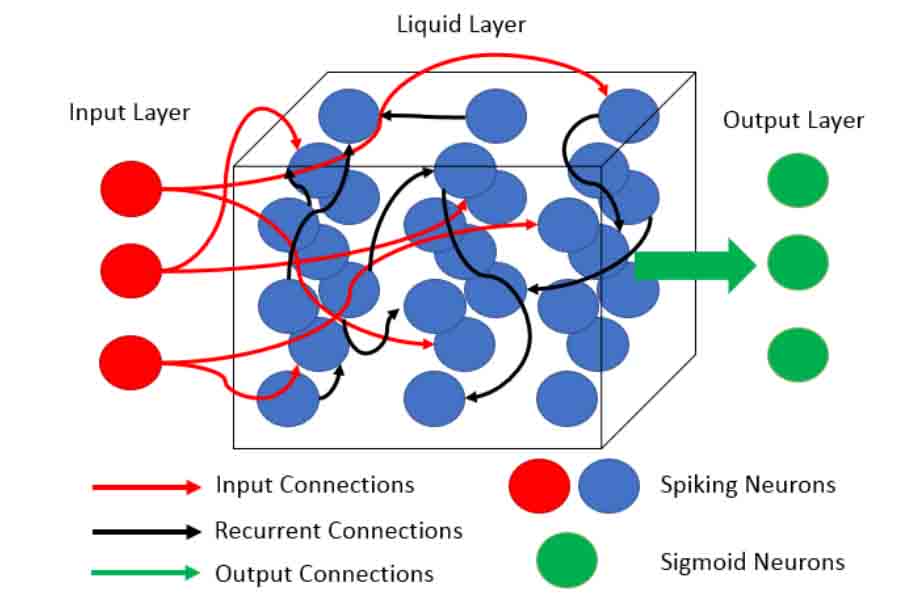
Researchers at MIT have developed a new kind of neural network called liquid networks. Unlike the traditional liquid networks, the new liquid neural network is dynamic and can adapt to new inputs. In this post, we will talk about the new liquid neural network. We will discuss its architecture, advantages over the traditional models, and possible applications.
Introduction to Artificial Neural Networks
Before getting into the complexity of the new neural network, let’s talk about Neural Networks. Artificial neurons are programs/algorithms that act like biological neurons. In the field of computing, a neuron is a mathematical model of function that takes weighted inputs, sums them, and activates them before sharing the results with other networks. By feeding the artificial neuron with the input of different weights, we can train it for our desired result (or output).
An artificial neural network is a complex structure of different layers of neurons. There are multiple connections between neurons in the network and an input passes through these neurons multiple times before the network outputs a final result. An output of a neuron is input to other and all the neurons help in refining the input for the ultimate output.
A neural network is modeled and trained depending upon what kind of output is expected from it. As of now, neural networks have been successfully used in prediction, autonomous systems, and recognition tasks.
Liquid Neural Network
Fundamental Difference
The limitation in the neural networks prior to the liquid neural networks is their training data set. What that means is the complete behavior of the network including how it responds to certain inputs is firm. As a result, neural networks are not flexible enough to change it based on the real-time inputs.

In contrast to this, the liquid neural network is flexible. The underlying equation can change in accordance with the new inputs. For this, researchers have changed the differential equations that represent the neuron. These new neurons can change parameters based on the results of the equations. As a result, the new networks are dynamic in nature.
Performance and Size
In the test, the new neural network bettered other time series algorithms by few percentages in prediction tasks. The neural network also has smaller and fewer computing nodes. The researchers believe that the few yet richer nodes in the liquid neural network will scale down the models.

Applications
The new neurons will have a great impact on how we process time-series data. Researchers believe the world is all about sequences. This includes our perception of the world too. Our reality is full of time-series data. Thus, with improved time series data analysis, we can develop future technologies.
The liquid neural network can anticipate future behavior in the system by analyzing data in real-time. This will be very helpful in systems that need to make decisions based on real-time data input. Thus, we could see the use of liquid neural networks in medical diagnosis and self-driving vehicles.
- Check out our review of the Samsung Galaxy Buds Pro.
















![Best Ultrabooks To Buy in Nepal 2024 [Updated] Best Ultrabook Laptops in Nepal 2023 - June Update](https://cdn.gadgetbytenepal.com/wp-content/uploads/2023/04/Best-Ultrabook-Laptops-in-Nepal-2023-June-Update.jpg)
![Best Gaming Laptops in Nepal 2024 [Updated] Best Gaming Laptops in Nepal 2023 - June Update](https://cdn.gadgetbytenepal.com/wp-content/uploads/2023/04/Best-Gaming-Laptops-in-Nepal-2023-June-Update.jpg)


![Best Mobile Phones Under Rs. 15,000 in Nepal [Updated] Best Phones Under 15000 in Nepal 2024 Budget Smartphones Cheap Affordable](https://cdn.gadgetbytenepal.com/wp-content/uploads/2024/03/Best-Phones-Under-15000-in-Nepal-2024.jpg)
![Best Mobile Phones Under Rs. 20,000 in Nepal [Updated] Best Mobile Phones Under NPR 20000 in Nepal 2023 Updated Samsung Xiaomi Redmi POCO Realme Narzo Benco](https://cdn.gadgetbytenepal.com/wp-content/uploads/2024/01/Best-Phones-Under-20000-in-Nepal-2024.jpg)
![Best Mobile Phones Under Rs. 30,000 in Nepal [Updated]](https://cdn.gadgetbytenepal.com/wp-content/uploads/2023/12/Best-Phones-Under-30000-in-Nepal-2024.jpg)
![Best Mobile Phones Under Rs. 40,000 in Nepal [Updated] Best Phones Under 40000 in Nepal 2024 Smartphones Mobile Midrange](https://cdn.gadgetbytenepal.com/wp-content/uploads/2024/02/Best-Phones-Under-40000-in-Nepal-2024.jpg)
![Best Mobile Phones Under Rs. 50,000 in Nepal [Updated] Best Phones Under 50000 in Nepal 2024 Smartphones Midrange](https://cdn.gadgetbytenepal.com/wp-content/uploads/2024/02/Best-Phones-Under-50000-in-Nepal-2024.jpg)
![Best Flagship Smartphones To Buy In Nepal [Updated] Best Smartphones in Nepal 2024 Flagship Premium Samsung Apple iPhone Xiaomi OnePlus Honor](https://cdn.gadgetbytenepal.com/wp-content/uploads/2023/09/Best-Smartphones-in-Nepal-2024.jpg)